JEE Main Important Physics formulas
ApplyAs per latest 2024 syllabus. Physics formulas, equations, & laws of class 11 & 12th chapters
NCERT Solutions for Class 9 Science Chapter 8 Motion: Welcome to the updated NCERT solutions for Class 10. On this Careers360 page, you'll find comprehensive NCERT solutions for class 9 science chapter 8 exercise questions crafted by subject experts, presented in detail and easy-to-understand language. Additionally, students can download the Class 9 PDF for free. Our expert team has developed class 9 science chapter 8 solutions that simplify complex concepts. This chapter includes ten exercise questions, along with important formulas and diagrams to aid students in exam preparation, as well as completing assignments and homework effectively."
Let's now read the comprehensive article on class 9 chapter 8 science solution, enabling us to solve the provided questions and gain insights into the essential formulas and key points covered in this chapter.
Also Read,
Understanding formulas is crucial for solving motion class 9 numericals and grasping the concepts of the chapter. Here are some important formulas from the Motion chapter that will aid you in solving questions:
Speed(s) = Distance (d) / Time (t) [SI unit of speed= m/s]
Average Speed = Total distance travelled / Total time taken [SI unit of average speed= m/s]
Velocity(v) = Displacement/Time=Δx/Δt [SI unit of velocity= m/s]
Average velocity = Total displacement / total time [SI unit of average velocity= m/s]
Acceleration (a) = Change in Velocity (Δv) / Change in time (Δt) [SI unit of acceleration= m/s2]
v= u+at
S = ut + ½ at2
V2 = u2+2as
By comprehending the formulas mentioned above, students will be equipped to solve questions within the motion chapter class 9 and successfully complete assignments and tests. Formulas serve as essential tools for tackling numerical problems. Furthermore, Careers360 experts have compiled a comprehensive list of important chapter-wise formulas for NCERT Solutions for Class 9 Science, which students can access by clicking the link provided below:
Download Ebook - NCERT Class 9 Science: Chapterwise Important Formulas, Diagrams, And Points
This resource will further aid students in their understanding and application of formulas across various chapters, thereby enhancing their overall preparation and performance.
Below is a list of important topics covered in motion class 9 solutions that will greatly assist you in exam preparation, completing assignments, and tackling tests:
Additionally, it's crucial to keep in mind the following motion-related key points:
By studying these important topics and concepts, students will develop a solid understanding of motion and be well-prepared to solve related problems.
This chapter has been renumbered as Chapter 7 in accordance with the CBSE Syllabus 2023–24.
Class 9 Science Chapter 8 Motion: Solved In-text Questions-
Answer:
Yes, an object has moved through a distance can have zero displacements.
If an object moves and returns to the original position, the displacement will be zero. Consider the movement in a circular path. A man walks from point A in a circular path in a park and comes back to point A.
The distance traveled is equal to the circumference of the circular path, but displacement is zero.
Answer:
Side of the square field = The perimeter of the square =
According to question,
He completes 1 round in .
Speed of the farmer =
Distance covered in
=
Now,
Number of round trips completed traveling =
We know, in 3 round trips the displacement will be zero.
In round, the farmer will reach diametrically opposite to his initial position.
Displacement =
Q 3. Which of the following is true for displacement?
(a) It cannot be zero.
(b) Its magnitude is greater than the distance traveled by the object.
Answer:
(a) The first statement is false. Because displacement can be zero when the initial point coincides with the final point.
(b) The second statement is false. The magnitude of displacement can never be greater than the distance travelled by the object. It can be either equal or less.
Topic 8.2 Measuring the Rate of Motion
Q 1. Distinguish between speed and velocity.
Answer:
| Speed | Velocity |
Speed is the distance travelled by an object in unit time | Velocity is the speed of an object moving in a definite direction. |
| Speed is a scalar quantity | Velocity is a vector quantity |
| Speed does not depend on the direction | Velocity changes with change in direction |
| Speed can never be negative | Velocity can be positive, negative or zero. |
Answer:
When the total distance traveled by the object is equal to the displacement, the magnitude of the average velocity will be equal to the average speed. Average speed is the total distance upon the time taken, whereas average velocity is the total displacement upon time taken.
Q 3. What does the odometer of an automobile measure?
Answer:
Odometer is a device that measures the total distance traveled by automobile.
Q 4. What does the path of an object look like when it is in uniform motion?
Answer:
An object is having a uniform motion if it covers equal distance in equal interval of time (which implies speed is constant!). So the path can be straight or curved.
For eg. Consider a circular path. For understanding purposes, divide the circumference of the circle in six equal parts each subtending at the centre. The object covers each equal part in equal amount of time. Hence, by definition, this object is in uniform motion.
Answer:
Given, the signal travels at the speed of light, .
Time taken by the signal =
Let the distance of the spaceship from the ground station be
We know,
Therefore, the distance of spaceship from the ground station is
Topic 8.3 Rate of Change of Velocity
Q 1. When will you say a body is in
(i) uniform acceleration?
(ii) nonuniform acceleration?
Answer:
(i) If the velocity of an object traveling in a straight line increases or decreases by equal amounts in equal intervals of time, then the acceleration of the object is said to be uniform. For example, An apple having a free-fall motion.
(ii) On the other hand, if the velocity of the object increases or decreases by unequal amounts in equal intervals of time, then the acceleration of the object is said to be non-uniform. For example, A car travelling along a straight road increasing its speed by unequal amounts in equal intervals of time.
Q.2 A bus decreases its speed from 80 km h -1 to 60 km h -1 in 5 s. Find the acceleration of the bus.
Answer:
(We know, )
Given, Initial speed of the bus, =
The final speed of the bus, =
Time is taken,
We know,
The negative sign implies retardation.
Therefore, the acceleration of the bus is
Or, the retardation(de-acceleration) of the bus is
Answer:
(We know, )
Given, The train starts from rest. Hence, the initial speed of the train =
Final speed of the train =
Time taken,
We know,
Therefore, the acceleration of the train is
Motion Class 9 Topic 8.4 Graphical Representation of Motion
Q 1. What is the nature of the distance-time graphs for uniform and non-uniform motion of an object?
Answer:
Distance-time graph is the plot of distance travelled by an object along x-axis against time along y-axis.
For the uniform motion of an object, the distance-time graph is a straight line with a constant slope.
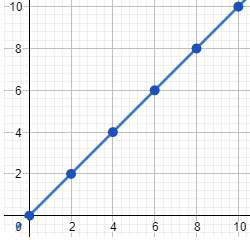 For non-uniform motion of an object, the distance-time graph is a curved line with an increasing or decreasing slope.
For non-uniform motion of an object, the distance-time graph is a curved line with an increasing or decreasing slope.

Answer:
If the distance-time graph of an object is a straight line parallel to the time axis, it means that the distance of the object is the same from its initial position at any point of time. This implies that the object is not moving and is at rest.
Answer:
If the speed-time graph of an object is a straight line parallel to the time axis, it means that the speed of the object is not changing with time. Hence the speed of the object is constant. This also implies that the acceleration of the object is zero.
Q4. What is the quantity which is measured by the area occupied below the velocity-time graph?
Answer:
The area occupied below the velocity-time graph denotes the total distance travelled by an object in the given time frame.
We know,
Topic 8.5 Equations of motion by graphical method
Q1.(a) A bus starting from rest moves with a uniform acceleration of 0.1 m s -2 for 2 minutes. Find
Answer:
Given, The bus starts from rest. Hence, the initial speed of the bus =
Acceleration of the bus, =
Time is taken,
(a) We know,
Therefore, the speed acquired by the bus is
Q1.(b) A bus starting from rest moves with a uniform acceleration of 0.1 m s-2 for 2 minutes. Find
Answer:
Given, The bus starts from rest. Hence, the initial speed of the bus, u =
Acceleration of the bus, =
Time taken,
(b) We know,
Therefore, the distance travelled by bus is
Answer:
(We know, )
Given, Initial speed of the train, =
Acceleration of the train, (Negative sign implies retardation)
Since, the train has to be brought to rest, final speed of the train, =
We know,
Therefore, the train travels a distance of before coming to rest.
Answer:
Given, The trolley starts from rest. Hence, the initial speed of the trolley, =
Acceleration of the trolley, =
Time is taken,
(a) We know,
Therefore, the velocity of the trolley after 3 sec is
Answer:
Given, Initial speed of the racing car, u =
Acceleration of the car, =
Time taken,
We know,
Therefore, the distance travelled by the racing car in is
Answer:
Taking upward direction as positive (+) direction:
Given,
(This is due to gravitational force!)
The stone will move up until its velocity becomes zero.
We know,
Therefore, the stone reaches to a height of
Now,
We know,
Therefore, the time taken by the stone to reach the maximum height is .
Answer:
Given, Diameter of the circular track =
The circumference of the circular track,
The athlete completes one round of a circular track in 40 s.
Speed of the athlete =
In ,
Distance travelled by the athlete =
Also, number of rounds the athlete will complete in =
Therefore, the final position of the athlete after will be diametrically opposite to his initial point.
(3 complete rounds and one half round.)
Hence, displacement of the athlete = magnitude of diameter of the circle =200m
(a) from A to B and
(b) from A to C?
Answer:
Given,
(a) Distance between A and B =
Time taken to reach from A to B =
Average speed from A to B =
And, Average velocity from A to B =
(In this case, average speed is equal to the average velocity)
(b) Distance travelled from A to reach C =
And, Displacement from A to C =
Also, time taken to reach C from A =
Average speed from A to C =
And, Average velocity from A to C =
(In this case, average speed is not equal to the average velocity)
Q 3. Abdul, while driving to school, computes the average speed for his trip to be . On his return trip along the same route, there is less traffic and the average speed is
. What is the average speed for Abdul’s trip?
Answer:
Given, Average speed while going to school,
And Average speed while returning back from school,
Let the distance between starting point and school be
And time taken by Abdul during the two trips be
We know,
And, -(i)
Now, Total distance that Abdul covers =
And total time Abdul takes to cover this distance =
Therefore, the average speed for Abdul's trip is
(Note: )
Q 4. A motorboat starting from rest on a lake accelerates in a straight line at a constant rate of for 8.0 s. How far does the boat travel during this time?
Answer:
Given, The motorboat starts from rest. Hence, initial speed of the motorboat, u =
Acceleration of the motorboat, =
Time taken,
We know,
Therefore, the distance travelled by the motorboat is
Answer:
The initial speed
After 5 sec the car stops
The graph is represented by the blue line ( x-axis is time and the y-axis is speed)
For the car with 3Kmh -1 . Initial speed . The graph which is represented by the golden line
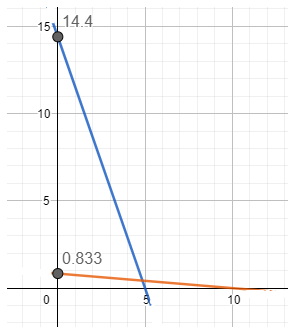
The area covered by the blue graph is greater than the golden graph so the car with 15 m/s initial velocity travells large distance.

Answer:
Given is a distance-time graph. The slope of this graph gives us speed. Hence, the graph with the highest slope will have the highest speed.
Since B has the highest slope(inclination), it travels the fastest.
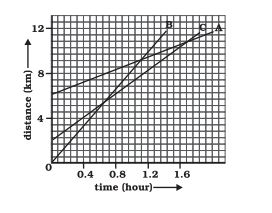
Answer:
Given is a distance-time graph. Any point on the curve will give the distance of object from O. Since there is no intersection point of all the three graphs, they never meet at the same point on the road.
(Although any two of them do meet at some point on the road!)
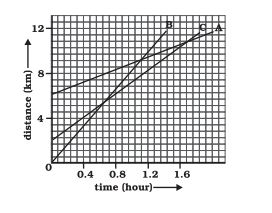
Answer :
Given is a distance-time graph. Any point on the curve will give the distance of object from O. To find how far C has travelled when B passes A, draw a perpendicular from the intersection point of A and B on time axis. The point where it intersects on the C graph, from C draw a perpandicular to y axis . Therefore, distance travelled by C will be (Final distance from O - Initial distance from O)
Therefore, C has traveled 6.5 km when B passes A.
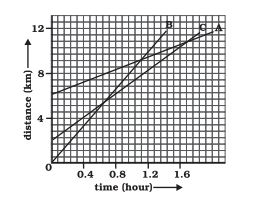
Answer:
Given is a distance-time graph. The graph of B and C intersect at a point whose y-coordinate is 5. Hence, B has travelled by the time it passes C.
Answer:
Considering downward direction as positive direction.
Given, Height from which ball is dropped,
Acceleration of the ball, =
Initial velocity,
(i) We know,
(In downward direction)
Therefore, the ball will strike the ground with a velocity of
(ii) Now, we know,
Therefore, the ball reaches the ground in .
Note: was rejected because in this case, the negative sign implies the velocity in upward direction, which is opposite to the direction of the motion of the ball(before collision).
Q 8.(a) The speed-time graph for a car is shown is Figure:

Find how far does the car travel in the first 4 seconds. Shade the area on the graph that represents the distance travelled by the car during the period.
Answer:
Given is a speed-time graph. The area under the curve will give the distance travelled by the car.
In time , the distance travelled by the car will be equal to the area under the curve from
Considering this part of the graph as a quarter of a circle whose radius = 4 unit.
Therefore, required area =
Therefore, distance the car travelled in the first 4 seconds is
Q 8. (b) The speed-time graph for a car is shown is Figure:
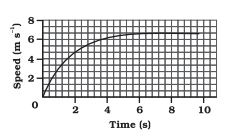
Which part of the graph represents uniform motion of the car?
Answer:
In uniform motion, the speed of car will become constant which is represented by line parallel to the time axis. In the given figure, the straight line graph from represents the uniform motion of the car.
Q 9. (a) State which of the following situations are possible and give an example for each of these:
Answer:
(a) The given situation is possible.
When an object is thrown upwards (under gravity only), it reaches to a maximum height where its velocity becomes zero. However, it still has an acceleration acting in the downward direction (acceleration due to gravity).
Note: This is possible for a given point of time, however, it is not possible for a period of time.
Q 9.(b) State which of the following situations are possible and give an example for each of these:
Answer:
(b) The given situation is possible.
An object moving in a circular path with uniform speed, i.e covering equal distance in equal amount of time is still under acceleration. Because, the velocity keeps on changing due to continuous change in the direction of motion. Therefore, circular motion is an example of an object moving with an acceleration but with uniform speed.
Q 9. (c) State which of the following situations are possible and give an example for each of these:
Answer:
(c) The given situation is possible.
For an object moving in a circular path with constant speed, the direction of its velocity at any point will be tangential to that point. However, its acceleration will be directed radially inwards. (Constant speed but still having an acceleration - Due to continuous change in direction.)
Answer:
Given, Radius of the circular orbit =
Circumference of the orbit =
The satellite takes 24 hours to revolve around the earth.
We know,
Therefore, the speed of the artificial satellite is
The 8th chapter of NCERT Solutions for Class 9 Science titled "Motion," provides a comprehensive understanding of the term motion. After studying this chapter, you will be able to answer the question. Motion is a relative concept, where the perception of movement depends on the observer's frame of reference. For instance, when we are travelling on a bus, a person sitting behind us appears to be at rest in relation to us. However, for someone outside the bus, that person is in motion. Moreover, while travelling, we may notice objects like trees seemingly moving, which can be attributed to the phenomenon of relative motion. This chapter, Motion Class 9 Science, presents numerous examples and explanations to deepen your comprehension of this fundamental physical concept.
By using some good examples, NCERT solutions for Class 9 Science chapter 8 Motion will also give you a better understanding of the concept. For example, if a person says that my home is 60 Km north of the airport. Here, the reference point is the airport. To specify the position of an object we need to choose a reference point and a direction. If in the previous case the person says that my home is 60 Km from the airport then we can go 60 Km in any direction. To know the exact point specifying direction along with reference is also important. Along with class 9 science chapter 8 question answer for Motion Class 9 Science Chapter, you will also get NCERT solutions for the additional questions mentioned in between the chapter.
Formulae are essential for solving motion class 9 questions answers. These formulae allow you to calculate various parameters related to motion, such as speed, velocity, acceleration, and distance travelled.
An important topic of the NCERT Solutions for Class 9 Science Chapter 8 is equations of motion for an object moving with uniform acceleration. If the initial velocity is u, the final velocity is v and t is the time taken and s is the distance travelled then the following are the three equations of motion.
Motion Class 9 Numericals
i) what is the distance travelled when the ant is at B. Is the distance equal to displacement?
Solution:
Displacement =AB=diameter =14cm. So distance not equal to the displacement
ii) what is the total distance travelled and the final displacement?
Total distance travelled = circumference of the circle =
Displacement =0 as the initial and final position are the same
iii) What is the time taken by the ant to travel from A to B
The time = distance / speed = 22 / 1 = 22 sec
Class 9 Chapter 8 Science Topics
Topics for class 9 physics motion are given below:
8.1 Describing Motion
8.1.1 Motion along a straight line
8.1.2 Uniform Motion and Nonuniform Motion
8.2 Measuring the rate of motion
8.2.1 Speed with Direction
8.3 Rate of Change of Velocity
8.4 Graphical Representation of Motion
8.4.1 Distance- Time Graphs
8.4.2 Velocity-Time Graphs
8.5 Equations of Motion by Graphical Method
8.5.1 Equation for Velocity-Time Relation
8.5.3 Equation for Position-Velocity Relation
8.6 Uniform Circular Motion
The study of motion in physics is a part of classical mechanics and is taught in class 9 science ch 8. However, if students did not understand the chapter or missed out on theclass 9 science chapter 8 question answer, they need not worry as they have come to the right place. In this article, we provide a comprehensive guide on NCERT solutions for class 9 science chapter 8.
Additionally, students can also access NCERT Solutions for Class 9 Maths, which will enable them to revise the complete syllabus and score better marks in their examinations. These resources will help students understand and master the concepts of motion and related numerical problems for a better understanding and performance in their exams.
If you stuck anywhere or want to complete your homework on time, refer to the solutions mentioned below:
NCERT Books and NCERT Syllabus:
NCERT Solutions for Class 9 Science- Chapter Wise
| Chapter No. | Chapter Name |
| Chapter 1 | Matter in Our Surroundings |
| Chapter 2 | Is Matter Around Us Pure |
| Chapter 3 | Atoms and Molecules |
| Chapter 4 | Structure of The Atom |
| Chapter 5 | The Fundamental Unit of Life |
| Chapter 6 | Tissues |
| Chapter 7 | Diversity in Living Organisms |
| Chapter 8 | Motion |
| Chapter 9 | Force and Laws of Motion |
| Chapter 10 | Gravitation |
| Chapter 11 | Work and Energy |
| Chapter 12 | Sound |
| Chapter 13 | Why Do We Fall ill? |
| Chapter 14 | Natural Resources |
| Chapter 15 | Improvement in Food Resources |
NCERT Solutions for Class 9 - Subject Wise
NCERT Science Exemplar Solutions Class 9 - Chapter Wise
| Chapter No. | Chapter Name |
| Chapter 1 | Chapter 1 Matter in our Surroundings |
| Chapter 2 | Chapter 2 Is Matter Around Us Pure? |
| Chapter 3 | Chapter 3 Atoms and Molecules |
| Chapter 4 | Chapter 4 Structure of the Atom |
| Chapter 5 | Chapter 5 The Fundamental Unit of Life |
| Chapter 6 | Chapter 6 Tissues |
| Chapter 7 | Chapter 7 Diversity in Living Organisms |
| Chapter 8 | Chapter 8 Motion |
| Chapter 9 | Chapter 9 Forces and Laws of Motion |
| Chapter 10 | Chapter 10 Gravitation |
| Chapter 11 | Chapter 11 Work and Energy |
| Chapter 12 | Chapter 12 Sound |
| Chapter 13 | Chapter 13 Why do We Fall ill? |
| Chapter 14 | Chapter 14 Natural Resources |
| Chapter 15 | Chapter 15 Improvement in Food Resources |
The questions on the chapter Motion can be practiced using NCERT exercise and NCERT exemplar questions.
In class 9, motion refers to the movement of an object from one location to another and includes measuring how fast the thing moves, in which direction it moves, and how much it moves. It assists students in understanding the fundamental physics principles relating to moving things.
In class 9 of chapter motion, Students learn about motion and different types of motion, such as rectilinear, circular, and periodic motion, and the concepts related to motion, including speed, velocity, acceleration, and displacement. They also learn about the graphical representation of motion, such as distance-time graphs and velocity-time graphs, and how to solve numerical problems related to motion. Understanding the fundamentals of motion is crucial for students studying science and physics, as it forms the basis for many concepts and theories in higher classes.
The motion itself is not a physical quantity, so it does not have an SI unit. However, there are several physical quantities related to motion that have their respective SI units, including:
Length or distance: meter (m)
Time: second (s)
Speed: meter per second (m/s)
Velocity: meter per second (m/s)
Acceleration: meter per second squared (m/s²)
Force: Newton (N)
Momentum: kilogram meter per second (kg·m/s)
Energy: Joule (J)
Power: Watt (W)

As per latest 2024 syllabus. Physics formulas, equations, & laws of class 11 & 12th chapters

Ranked #52 Among Universities in India by NIRF | Up to 30% Merit-based Scholarships | Lifetime placement assistance

Get up to 90% scholarship on NEET, JEE & Foundation courses

As per latest 2024 syllabus. Chemistry formulas, equations, & laws of class 11 & 12th chapters

Enrol in PACE IIT & Medical, Financial District, Hyd for JEE/NEET preparation

Start your JEE preparation with ALLEN